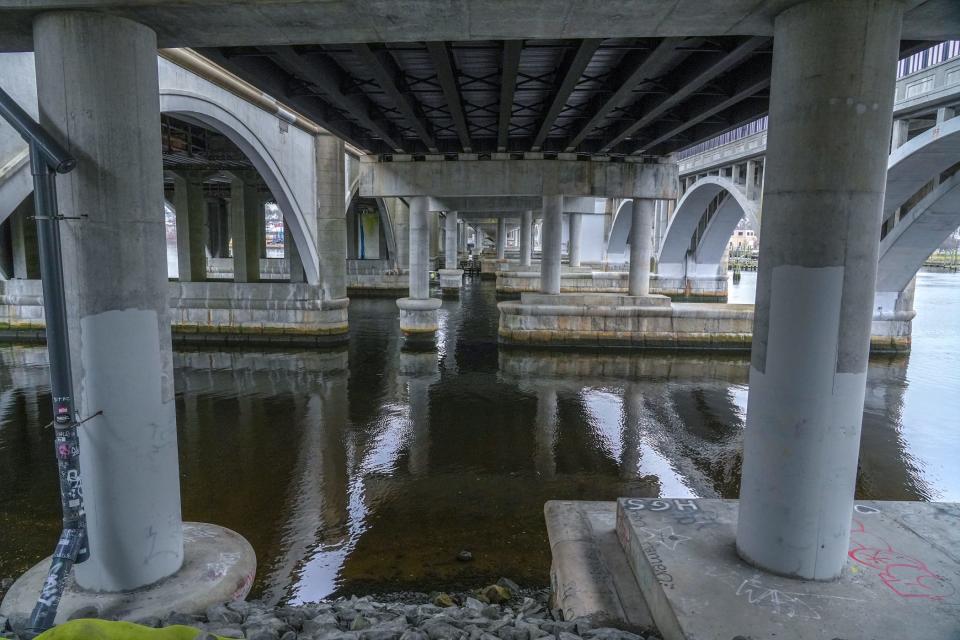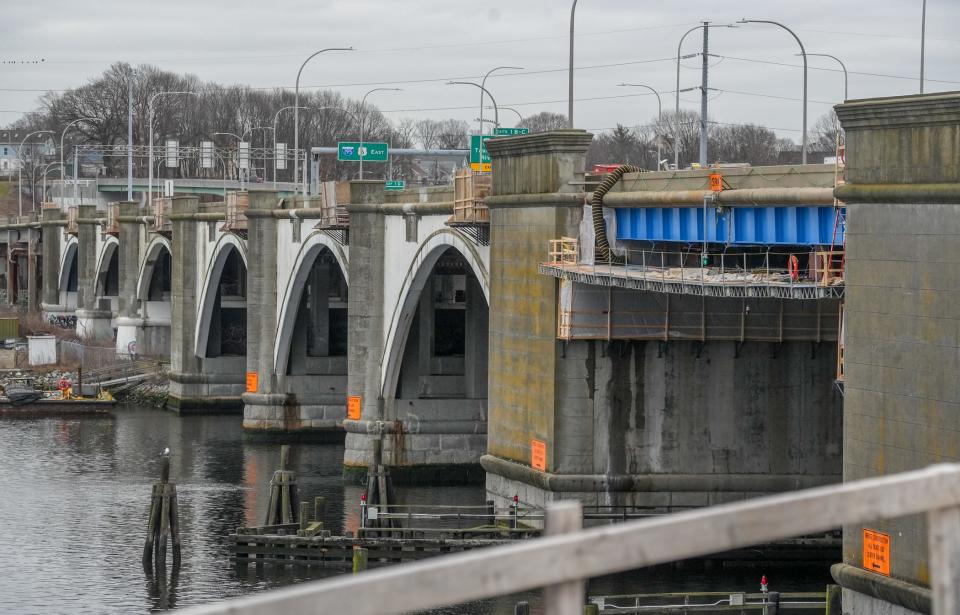Emails show initial warning, response to Washington Bridge damage
An early warning that something was seriously wrong with the Washington Bridge arrived in state Department of Transportation inboxes around 1:40 p.m. on Friday, Dec. 8, with the subject line: "Washington Bridge 700 Inspection – Critical Finding."
Andrew Prezioso, a structural engineer working for bridge design contractor VHB, had seen alarming damage to the anchor rods holding down parts of the bridge's westbound span, and he wanted to share video of it, taken at 10:18 that morning.
The images showed the "cantilever span bouncing at the bearing," he wrote to DOT Project Manager Anthony Pompei and a half-dozen other engineers that Friday, according to one portion of 236 pages of emails obtained by The Providence Journal through an Access to Public Records Request. (It is not yet clear how many more emails were withheld.)
DOT managing engineer: 'No immediate actions to be taken'
DOT Managing Engineer Keith Gaulin was the first to respond around an hour later.
"Based on our phone conversation, it seems there are no immediate actions to be taken right at this moment as we try to determine other short and long-term solutions," Gaulin wrote back to Prezioso, fellow DOT employees and contractors.
He went on: "As we discussed, it is noted this condition may have pre-existed but was not noticeable until now as this area is more exposed due to current construction work."
Gaulin's response is the closest state engineers and transportation experts have gotten to explaining how the bridge – which passed an inspection in July – was in danger of collapse by December.
It also suggests that DOT Director Peter Alviti Jr.'s conclusion that a catastrophic incident damaged the bridge is not the only interpretation.
Asked why Alviti aired this unsubstantiated theory, his spokesman Charles St. Martin said he "shared that theory based on the information available at that time. The governor and RIDOT each commissioned a forensic investigation to get outside expertise better evaluate the cause of the damage."

It was not fully clear until Wednesday when McKee was first notified of the critical findings that came to light on Friday, Dec. 8, St. Martin said "shortly after" Alviti's Monday afternoon decision to close the bridge.
Repeating what was previously known, McKee spokeswoman Olivia DaRocha said: "At 2:52 p.m. on Dec. 11, Director Alviti advised the governor that the bridge had to be closed for public-safety reasons. With this being a significant public-safety issue, the governor knew closing the bridge was the only option.
"The governor feels that he should have been informed earlier than Monday afternoon," she said.
Emails show a scramble to manage fallout when bridge closed
But the hundreds of emails about the bridge exchanged the week that damage to the bridge was detected – and which the DOT charged The Journal $450 for – show McKee's administration scrambling to manage the fallout when the highway bridge that carried 90,000 vehicles a day over the Seekonk River was closed to traffic on the evening of Monday, Dec. 11.
But they shed little light on the thinking the state's bridge experts or McKee's senior staff went through to decide what to do about it.
There were no emails among the hundreds provided by the DOT from Alviti or Chief of Staff John Igliozzi.
The first concern that emerged in the written record at the DOT in the wake of Prezioso's email on Friday, Dec. 8, was about trucks using the left-hand travel lane.
"It was mentioned in our phone conversation about the possibility of restricting trucks from the left lane, but I was subsequently informed that RIDOT Maintenance placed signs stating as such last week. So, trucks are currently prohibited from the left lane," Gaulin wrote.
Two days ago, DOT spokesman Charles St. Martin said trucks are always banned from the left lane of the bridge, and that the new signs had nothing to do with the bridge damage.
At 2:45 p.m. on Friday, Dec. 8, Pompei wrote to colleagues: "I've been monitoring the RIDOT traffic camera at the bridge for the last 10-15 minutes and I did see one truck change lanes into the high-speed lane while on the bridge, but all others have been using the other lanes."
But as for what to do about the failing anchor rods that had the bridge span "bouncing," the engineers had to regroup.

RIDOT asks for meeting the next Monday morning
"Additional mitigation measures/repairs needs to be discussed [between RIDOT Bridge and VHB] ASAP," Gaulin wrote. "We request the RIDOT PM Office set up a meeting for Monday morning to review possible measures."
Over the weekend the email thread goes essentially silent. There are no written records of the conversations and over-the-weekend emergency discussions that Alviti has described taking place as the agency weighed what to do.
At 11:30 a.m. Monday, Dec. 11, the team convened for a video conference call and "Critical Finding Discussion."
No one put any notes in the chat, as far as the record shows. Prezioso reshared his video.
At 4:15 p.m., St. Martin wrote to the governor's office, sharing a draft of a news release announcing the shutdown of the bridge at 5 p.m.
There are even fewer written discussions of how the DOT planned to repair the bridge after it was shut down. Initially, it appears the DOT believed there could be a relatively quick fix that would get the westbound span open again.
"We are requesting to use RI Welding to fabricate the steel repair brackets once they are designed by VHB," Jeff Bostock, vice president of construction at Aetna Bridge, wrote to the DOT's Pompei and George Ley on Tuesday, Dec. 12. "We feel they will be able to respond the quickest and have the resources to expedite fabrication."
But even by that Tuesday, the first full day after the shutdown, there were signs the job might be more complicated than it first appeared.
On Tuesday this week, McKee, Alviti and Joseph Almond, the top aide McKee dispatched to DOT to be his eyes and ears, met with engineers involved in structural analysis, design and repair work for the Washington Bridge. The governor's office described it as an introductory meeting where McKee stressed the urgency.
Search underway for firm with expertise to evaluate damage
The DOT was searching for a company capable of figuring out how bad the damage was.
Pompei wrote to colleagues that "there is a lot of internal post-tensioning within the cantilevers and elsewhere on the bridge that has not been able to be inspected. There was the thought that one of the only companies in the country what may have the experience with possible options for testing these components would be Vector."
Daniel Kelley of Aetna Bridge responded: "I spoke with Vector, and they can do some evaluation/testing on the [post tension], but it seems like determining the actual condition is very difficult."
The next day, Wednesday, Dec. 13, Richard Corey of Aecom, another of the consultants working on the bridge, wanted to make sure "any of the steel components that may be subject to cyclical loading being checked/designed for fatigue."
"Can you confirm, for design purposes, that the long-term goal of the project is still a 25-year design life, as this would have to be accounted for in the fatigue analysis," he asked.
A previous version of this story misidentified the day of the week that the first email was sent.
This article originally appeared on The Providence Journal: Emails show initial warning, response to Washington Bridge damage

